Power Shift - Home Energy Retrofit
Air Date: Week of October 11, 2013
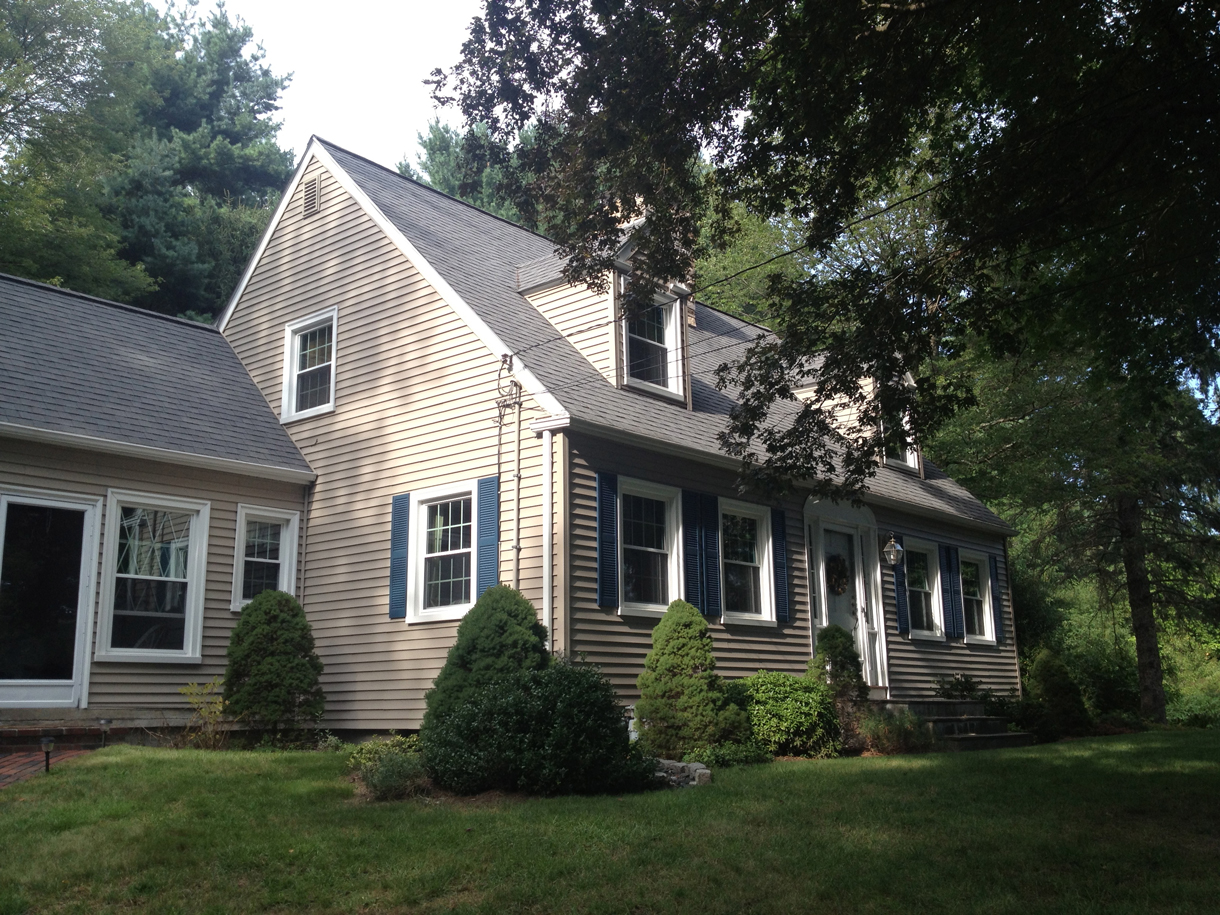
The Wesolowskis are trying to lower their energy bills at their house in Ashland, Massachusetts. (Photo: Poncie Rutsch).
There are many ways to make your home more energy efficient. In Massachusetts a partnership of northeastern utility companies aims to guide residents through these choices by providing free advice on cheapest ways to save energy. As part of our ongoing Power Shift series, reporter Poncie Rutsch followed a home energy auditor to see how the program works.
Transcript
CURWOOD: It’s Living on Earth, I’m Steve Curwood. And now, our occasional series on energy transformation, Power Shift.
[MUSIC: PAT METHENY- (ACROSS THE) HEARTLAND---FROM AMERICAN GARAGE]
CURWOOD: For two years, the American Council for an Energy-Efficient Economy has dubbed Massachusetts the greenest state in the nation, based on its policies to spur energy efficiency. One area where the Bay State shines is in its push to revamp and weatherize old housing stock. Every home can receive an annual visit from an energy efficiency guru who can advise the householder how to save the most energy for the least money. Living on Earth's Poncie Rutsch tagged along with a home assessor.
RUTSCH: It’s a clear New England day. John Brochu has just arrived at his first home assessment of the day - a typical New England cape-style house in Ashland, Massachusetts.
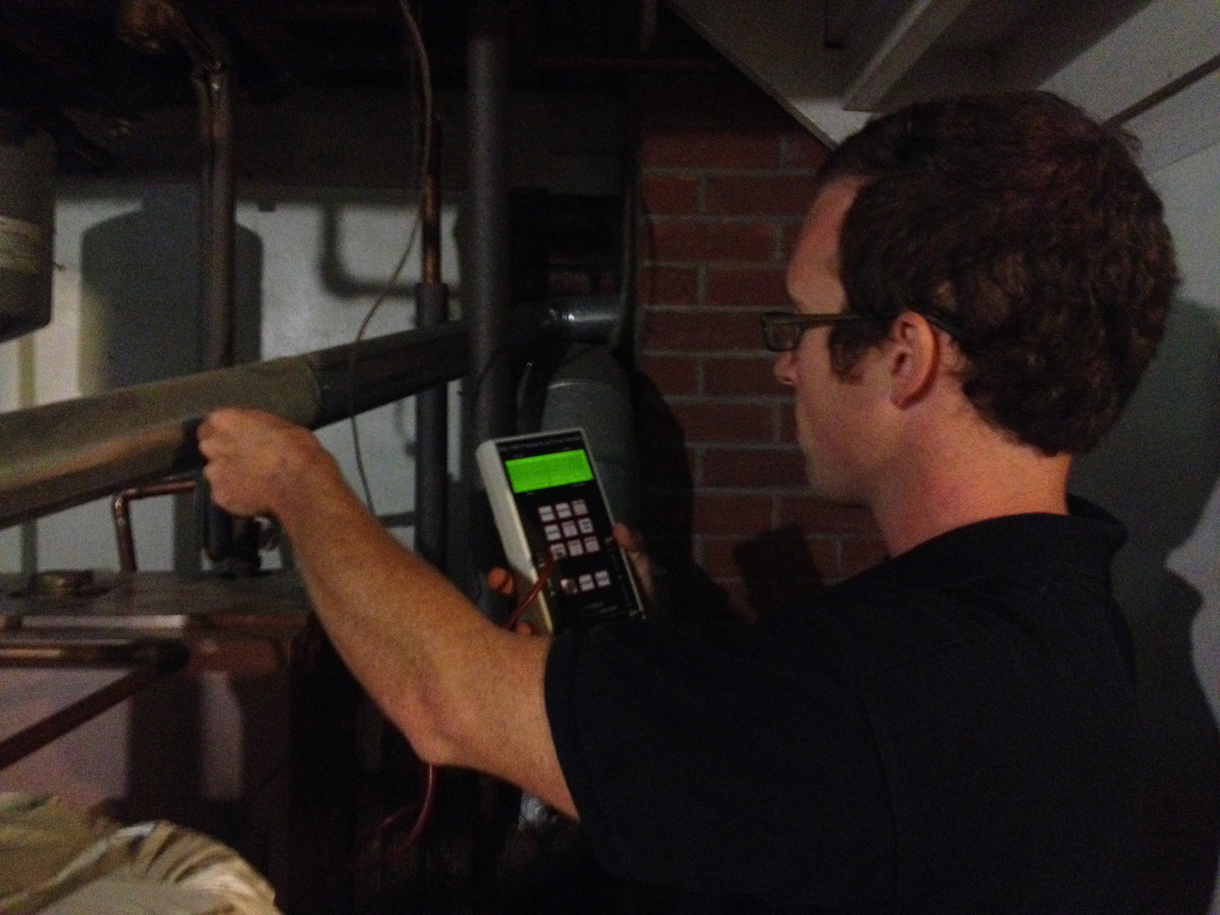
John Brochu, an energy auditor for Next Step Living, tests the efficiency of the HVAC system at the Wesolowski house in Ashland, Massachusetts. He can then tell the family about the possible discounts and rebates they can use to replace it for a more efficient one. (Photo: Poncie Rutsch).
BROCHU: Alrighty.
RUTSCH 2: Brochu works for Next Step Living, one of several hundred companies in the Northeast that analyze houses for energy saving opportunities, all in ways eligible for state-sponsored savings through the MassSave program, a partnership funded by utility companies. Today he’s assessing the house of Heidi and David Wesolowski.
BROCHU: Well thanks for having us out. Have you ever had an audit before?
WESOLOWSKI: No, we have not.
BROCHU: And you’ve only been here for a year I see.
WESOLOWSKI: We moved in June last year.
BROCHU: OK, alright, cool.
RUTSCH: The Wesolowskis are trying to save energy where they can. There are dozens of ways: insulate the house, replace incandescent lightbulbs, buy high efficiency appliances. All of these choices use less energy, but some are really expensive. If you’re on a budget, you can’t do it all, and it gets very confusing. Here’s Next Step Living CEO Geoff Chapin.
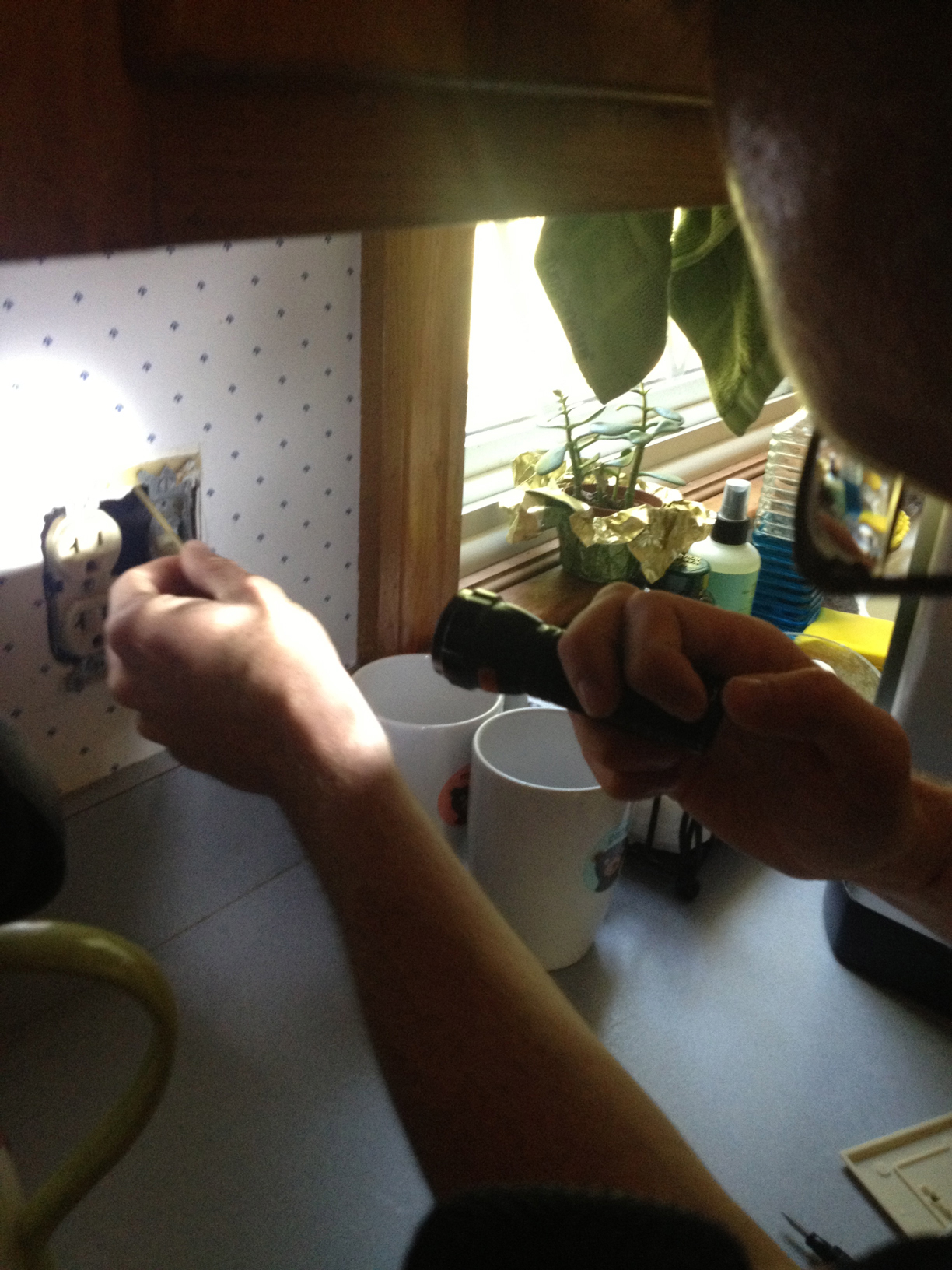
John Brochu, an energy auditor for Next Step Living, uses a barbecue skewer to determine how much insulation is between the walls at the Wesolowski house in Ashland, Massachusetts. (Photo: Poncie Rutsch).
CHAPIN: We really want to make a difference in terms of energy and climate.
RUTSCH: Next Step Living assessed nearly 18 thousand homes between January and the end of August this year. Before Brochu starts, he asks Heidi Wesolowski about her goals.
WESOLOWSKI: Well we moved in about a year ago. We would particularly like to look at the insulation and the heat escape because we know that the heating bill goes up in the winter time. And this year we have a baby so we’re home all day and we can’t turn the heat down while we leave during the day. We can’t turn the heat down at night time because he needs to be comfortable while he’s sleeping. So we have to go other ways.
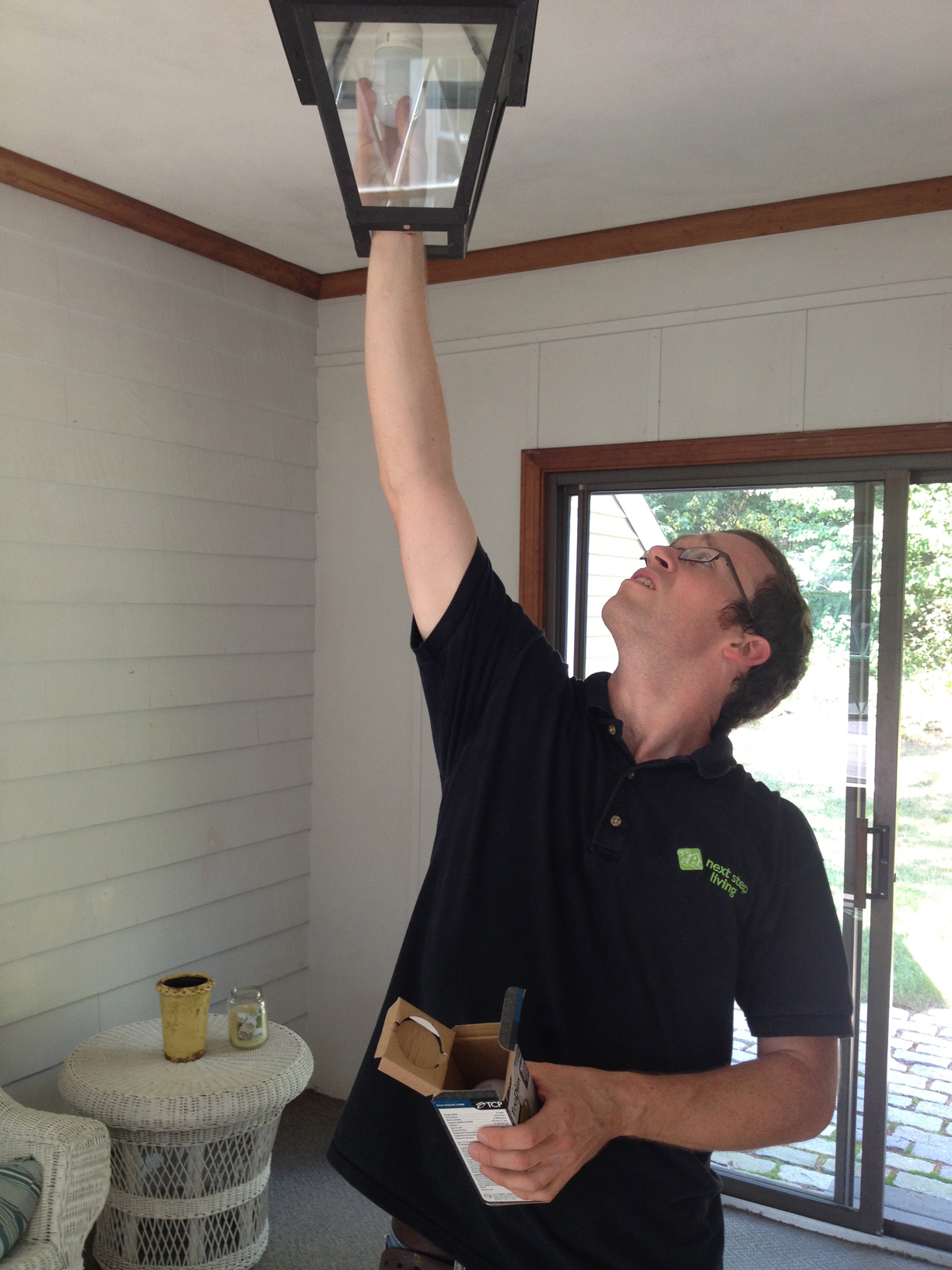
John Brochu, an energy auditor for Next Step Living, installs a more efficient CFL lightbulb at the Wesolowski house in Ashland, Massachusetts. The Mass Save program allows him to install as many lightbulbs as he has time for, free of charge. (Photo: Poncie Rutsch).
BROCHU: So I’ll just take a walk around out back.
[DOOR OPENS AND FOOTSTEPS]
RUTSCH: We circle the outside of the house slowly and Brochu scans the clapboard walls for any openings where heat could escape.
RUTSCH: Then we head back inside.
[SOUNDS OF SQUEAKY DOOR]
WESOLOWSKI: Welcome to our very inefficient door. We know for sure this door is an issue because it’s an old hatch door. And in the winter we can feel the air coming in through it.
RUTSCH: Brochu says that their stable door, with its separate bottom and top halves, can be sealed too.
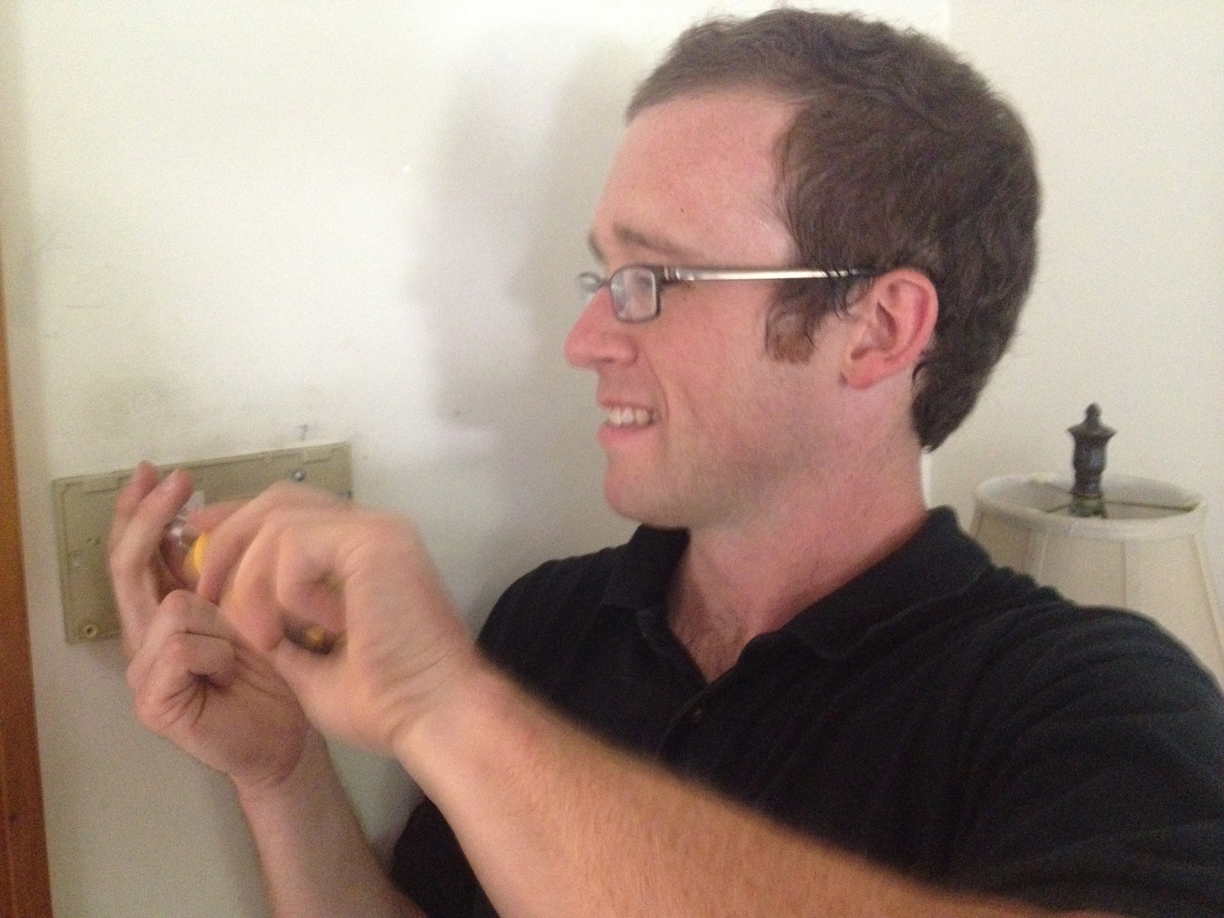
John Brochu, an energy auditor for Next Step Living, installs a new, programmable thermostat at the Wesolowski house. (Photo: Poncie Rutsch).
BROCHU: I’ve seen, where they actually have built in weather stripping here.
RUTSCH: Then, Brochu walks around the first floor inside, flipping switches on and off as he walks.
[EXHAUST FAN TURNS ON]
RUTSCH: Exhaust fans, like those above the stove and in the bathroom, sweep air from inside the house to the outdoors. Then there’s the chimney, a pretty big hole to the outside.
WESOLOWSKI: This fireplace is a functioning fireplace, but we do not use it.
BROCHU: OK, alright. Do you have a way of closing the flue there?
RUTSCH: Brochu flips on his flashlight and cranes his neck up the chimney
BROCHU: So it’s definitely good to make sure that this is closing, and it looks like it is.
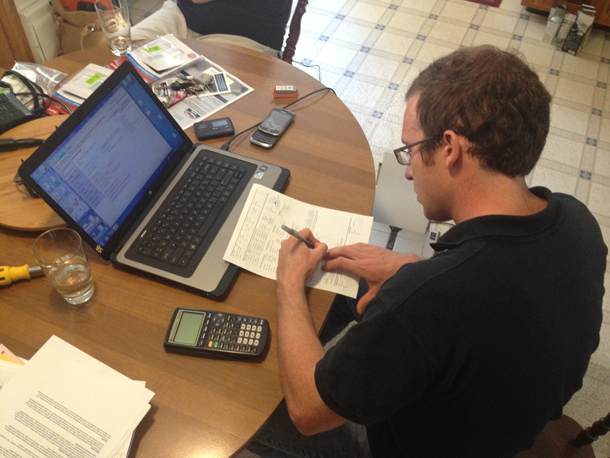
John Brochu writes down some notes and performs some quick calculations to figure out how these homeowners can save the most energy for the least expense. Brochu works as an energy auditor for Next Step Living, and he’s assessing the Wesolowski house in Ashland, Massachusetts. (Photo: Poncie Rutsch).
RUTSCH: When we finally make it to the basement, Brochu takes a quick look around and notes that the windows in the basement are single pane.
BROCHU: A lot of the hot air naturally wants to rise, right? But that movement called the stack effect also draws in cold air from lower extremities. So you have this motion of cold air coming in through the basement and hot air escaping up and out the attic.
RUTSCH: Then Brochu moves over to the hulking machines in the basement, the hot water boiler and the HVAC system. He uses a meter to see how much carbon monoxide is coming out.
BROCHU: We need to see it below 100 parts per million. She’s at 186.
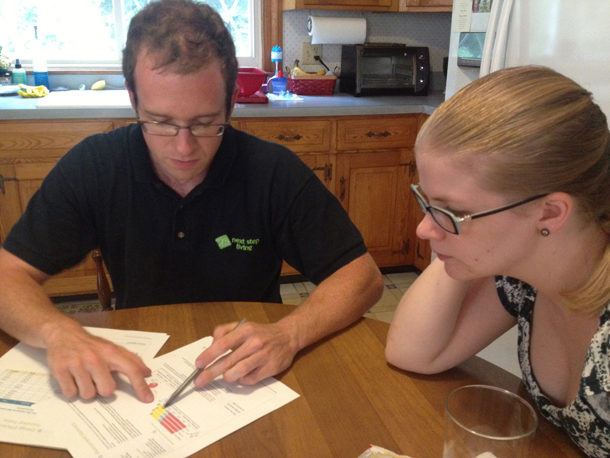
John Brochu shows Heidi Wesolowski her options for retrofitting her home to save energy. Brochu works as an auditor for Next Step Living, Wesolowski house in Ashland, Massachusetts. (Photo: Poncie Rutsch).
RUTSCH: Brochu tests the efficiency and says the Wesolowskis could save energy by upgrading their boiler. Plus, the boiler's old and will need to be replaced in the next few years. He records these numbers and then switches the heat off.
[HVAC TURNS OFF]
[BASEMENT STAIRS]
RUTSCH: Next, Brochu checks how well insulated the house already is.
BROCHU: So I’m going to go around and get an idea what’s behind the walls.
RUTSCH: Brochu breaks out his secret weapon.
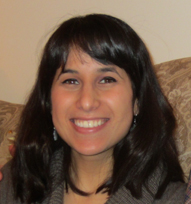
Monica Tawfik works for the home efficiency department of National Grid. Part of her job is to oversee companies like Next Step Living when they assess homes for energy efficiency. (Photo: National Grid).
BROCHU: This is just a really sophisticated barbecue skewer. So I’ll start by pulling off some outlet covers…
RUTSCH: Brochu pokes the skewer carefully into the sealed joints around the outlet. He’s listening closely and feeling for the fluffy insulation inside.
[SKEWER SLIDES INTO INSULATION]
RUTSCH: Brochu finds about three and a half inches of wall space, filled with two-and-a-half inches of insulation. He considers filling the remaining space with more insulation.
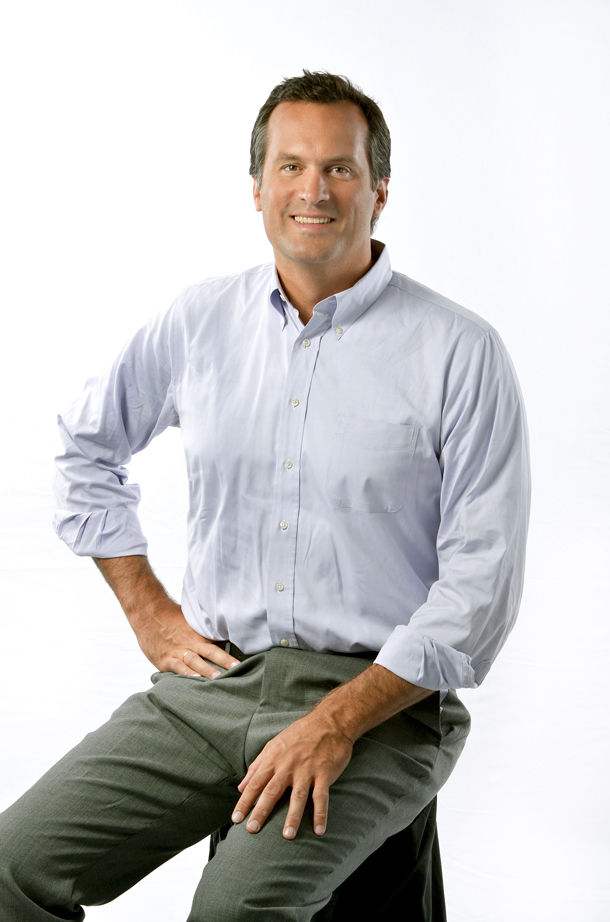
Next Step Living CEO Geoff Chapin says that the main goal of the company is to decrease energy usage and help the environment. (© 2013 Next Step Living, Inc. Photos: Perfect Bokeh Photography)
BROCHU: But if we only have inch of air space in there, the material doesn’t really install properly. So in this case we just have to call the walls good enough.
[ATTIC STAIRS]
RUTSCH: Then we move up to the attic.
BROCHU: The attic is, I kind of think of it as the hat on the house. So if attic is not properly air sealed and insulated, you lose a ton of heat out of that space.
RUTSCH: Brochu takes some notes on the space and how he could add insulation up here. Then it’s time for a lightbulb scavenger hunt. Brochu runs out to his car to grab a few of what he calls ISMs – Instant Savings Measures – or ways he can help the Wesolowskis right now.
[DOOR TO OUTSIDE; SOUNDS OF TRUNK OPENING]
RUTSCH: Brochu’s car is stuffed with energy saving toys – CFL lightbulbs, LEDs, smart power strips, new thermostats, and low flow shower heads.
BROCHU: Simple but really good example is the shower head. So, standard is two and a half gallons per minute, we have one that is one and three-quarter gallons per minute. So it seems pretty small but if you actually think about it that’s three-quarters of a gallon in a minute. Turns out to be quite a lot of water.
RUTSCH: He installs a new shower head in the bathroom, and then moves to lightbulbs.
BROCHU: Do you mind if I change this one out here?
[SCREWS IN A LIGHTBULB]
BROCHU: Alright, that works. Success.
RUTSCH: Brochu leaves as many lightbulbs as he possibly can.
BROCHU: There’s no limit, the only rule is that I have to leave them installed.
RUTSCH: And last, but not least, he looks at the climate control.
BROCHU: I notice you have two pretty old thermostats so I can give you some programmable ones.
RUTSCH: It’s taken Brochu about two hours to complete his assessment. He types up his notes and prints out his report.
BROCH: So this is a summary of what I did do today: showerheads, thermostats, etc. And the utilities, they subsidize this work 100 percent, so your total cost is that, zero, but the total cost paid by the utilities is $403.
RUTSCH: There are a few investments that Brochu suggests the Wesolowskis might make. They can get a discount on upgrading their hot water boiler and on insulating the attic. But before Next Step Living could install discounted insulation, the Wesolowskis would have to pay full price to remove some floorboards. Brochu is also pretty sure there'd be help to replace the drafty door.
BROCHU: That is, technically a single-paned window/door so that is financeable.
RUTSCH: But there’s a catch – it’s not a discount, it’s just a low interest loan.
BROCHU: So if you guys wanted to use the heat loan you could do that along with all the basement windows.
WESOLOWSKI: That might, yeah, be the way to go.
RUTSCH: Brochu hands Heidi a stack of papers. It’s easy to get overwhelmed by all the paperwork – the choices are endless. Out of all the homes that Next Step Living has assessed, less than half have completed the followup work like adding insulation or replacing windows. Home assessments are costly for the utility companies but they think it’s worth the expense.
TAWFIK: My name is Monica Tawfik. I am manager of the sales processing group here at National Grid.
RUTSCH: National Grid is one of about eight utility companies that pays for the MassSave program, which then contracts with companies like Next Step Living to assess people’s homes.
TAWFIK: The funding actually comes directly from your utility bill, so on every bill there’s a small surcharge that actually goes to fund the program.
RUTSCH: And in the end, saving energy is good for the energy utilities too.
TAWFIK: Energy efficiency actually helps us as a company by using less electricity or less gas. That’s one less power plant we need to build or invest in, so it’s less strain on our resources.
RUTSCH: Heavy snow and intense storms are common in the Northeast; anything utilities can do to reduce demand on the grid makes the system more resilient.
TAWFIK: So this year alone we are intending to serve 40,000 customers with home energy assessments and just through this program, we’re intending to save 14,000 megawatt hours on the electric side and over 1.5 million therms.
RUTSCH: That’s enough natural gas to heat 2,000 homes. Ideally, the people choosing to assess and weatherize their homes would be heavy energy users. But neither MassSave nor Next Step Living has analyzed who uses these programs. Both say that they really want to change the habits of the heavy hitters…the energy hogs. Here’s Monica Tawfik again.
TAWFIK: So we, obviously being the utility company, have access to the utility usage and bills so we do try to target the high energy users. But again the program really is available for anyone, whether you own the home, whether you rent the home, whether you’re a landlord, doesn’t make a difference. The opportunity’s there, the incentives are available for anyone.
RUTSCH: According to the Massachusetts Department of Energy and Environmental Affairs, nearly 75,000 homes and apartments received an assessment last year. Massachusetts has saved enough electricity to power nearly 5,000 homes for a year, and the program has helped the state reduce greenhouse gas emissions and meet the governor’s 25 percent reduction target for 2020.
So after all the assessing, we had to see what the Wesolowskis wanted to pursue.
WESOLOWSKI: Well we’re definitely interested in looking at the insulation. Something we thought about before we moved in. So it seemed like a good opportunity to get the insulation with someone who would know how to get us the savings that were associated.
RUTSCH: She says it’s partly about the environment and partly about saving money in her household.
WESOLOWSKI: I think it’s a combination of both. It’s great that you can do both at the same time, that one isn’t a tradeoff for the other. That when your energy consumption goes down you’re both saving money and helping the environment. It just seems like, why not?
RUTSCH: Why not indeed? For Living on Earth, I’m Poncie Rutsch in Ashland, Massachusetts.
Links
Living on Earth wants to hear from you!
Living on Earth
62 Calef Highway, Suite 212
Lee, NH 03861
Telephone: 617-287-4121
E-mail: comments@loe.org
Newsletter [Click here]
Donate to Living on Earth!
Living on Earth is an independent media program and relies entirely on contributions from listeners and institutions supporting public service. Please donate now to preserve an independent environmental voice.
NewsletterLiving on Earth offers a weekly delivery of the show's rundown to your mailbox. Sign up for our newsletter today!
 Sailors For The Sea: Be the change you want to sea.
Sailors For The Sea: Be the change you want to sea.
 The Grantham Foundation for the Protection of the Environment: Committed to protecting and improving the health of the global environment.
The Grantham Foundation for the Protection of the Environment: Committed to protecting and improving the health of the global environment.
 Contribute to Living on Earth and receive, as our gift to you, an archival print of one of Mark Seth Lender's extraordinary wildlife photographs. Follow the link to see Mark's current collection of photographs.
Contribute to Living on Earth and receive, as our gift to you, an archival print of one of Mark Seth Lender's extraordinary wildlife photographs. Follow the link to see Mark's current collection of photographs.
 Buy a signed copy of Mark Seth Lender's book Smeagull the Seagull & support Living on Earth
Buy a signed copy of Mark Seth Lender's book Smeagull the Seagull & support Living on Earth

